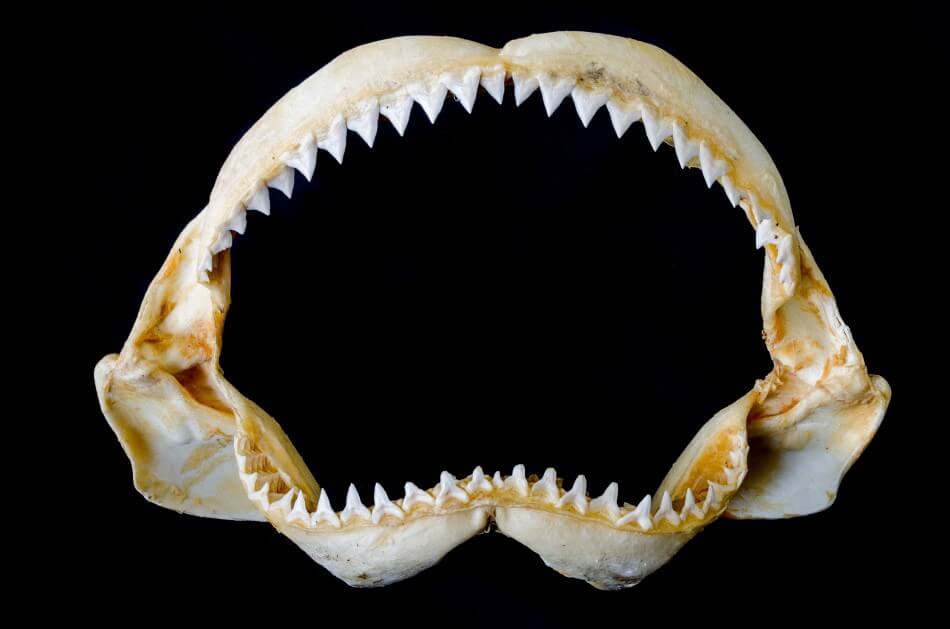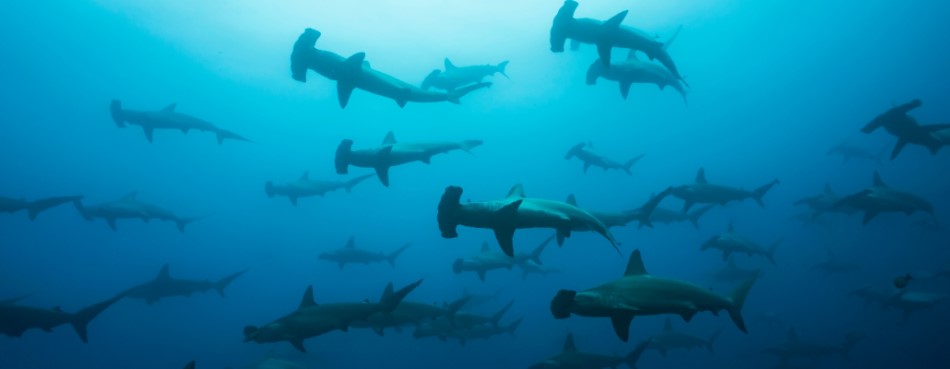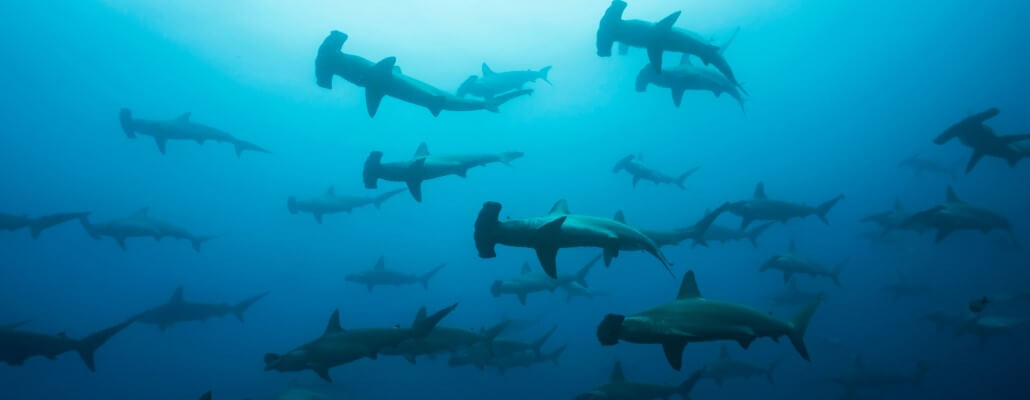Sitting at the top of the marine food chain, sharks are the majestic creatures of the sea, surrounded by myth and misconception and striking fear into many due to their often negative media coverage and movie portrayals. Although it is understandable that many would prefer not to come face to face with a shark, attacks on humans are extremely rare and they are much more scared of us than we could ever be of them.
Shark levels are actually declining, and they are amongst the most threatened marine vertebrates on Earth, with some species facing extinction. Sadly, many of the threats they face are a result of humans, and include recreational fishing, shark finning, habitat loss, pollution, and bycatching.
1. Sharks have been around for 400 million years.
Pre-dating dinosaurs and even trees!
2. Sharks have had little need to evolve.
A testament to just how effective their anatomical make-up is.
3. There are over 400 types of shark.
500 known species if you include those that are extinct.
4. Sharks vary widely in size.
From the 8 inch pygmy lantern shark, right up to the 60ft whale shark.
5. Despite their negative portrayal in media and film, shark attacks are extremely rare.
You’re more likely to be struck by lightning! Most shark attacks are because sharks have mistaken a human for prey such as a seal. Sharks do not actively hunt humans.
6. Shark anatomy is fairly consistent across the species.
But each have their own unique features, such as the hammerhead shark with it’s large sweeping head.
7. Sharks have skeletons made up of cartilage rather than bone.
Cartilage is more durable and lighter than bone, helping the shark save energy.
8. Unlike most fish, sharks don’t have a gas-filled swim bladder.
Instead, they have an oil filled liver that offers buoyancy, using this in conjunction with forward movement to control vertical position.
9. The jaws of sharks are not attached to their skull.
They move separately , allowing them to thrust forward and latch onto prey.
10. The surface of a shark’s jaws have extra support called ‘tesserae’.
These tiny hexagonal plates are made up of calcium salt deposits, giving cartilage more strength.
11. Shark’s may have up to 3,000 teeth at one time.
They are fully embedded into the gums, with shape and size varying depending on their purpose.

12. Sharks continuously grow multiple rows of teeth.
When a shark breaks or loses a tooth, a new one moves forward to replace it, much like a conveyor belt.
13. It’s estimated that some sharks may lose 30,000 or more teeth in their lifetime!
Tooth replacement rates vary from several days to several months.
14. Most sharks have 8 rigid fins.
A pair of pectoral fins, a pair of pelvic fins, one or two dorsal fins, an anal fin and a caudal fin (tail).
15. All sharks are carnivorous.
Ranging from small bivalves and crustaceans, to seals and even other sharks.
16. Sharks can be found in all seas.
They generally avoid fresh water with the exception of some species, and are commonly found to a depth of 2,000 meters.
17. Not all sharks are solitary hunters.
Many sharks a very social, hunting in packs or congregating in large numbers during breeding.

18. Sharks need to keep moving in order to breathe.
Some species have evolved to remain stationary, resting on the sea bed and pumping water over their gills.
19. Sharks never enter a true state of sleep.
Some species are able to ‘sleep swim’, as their swimming is coordinated by their spinal cord as opposed to their brain.
20. Sharks can detect blood at one part per million.
They can even determine the direction of a particular scent based on the time it takes to reach one nostril compared to the other.
21. Sharks have keen eyesight.
As well as their acute smell, sharks have great eyesight even in dimly lit environments. This is due to a mirror like layer in the back of the eye called the tapetum lucidum (the same found in cats).
22. Sharks have ears.
Located within a small opening on each side of their head. Sound travels faster in water, and sharks rely on sound heavily.
23. Sharks can detect electricity.
Sharks have electroreceptor organs called ‘ampullae of Lorenzini’, and they use this to detect electromagnetic fields which all living creatures emit.
24. Most sharks live 20-30 years.
Maturing slowly and reaching a reproductive age anywhere from 12 to 15 years.
25. Sharks are a k-selected species.
This means they produce a small number of larger, more developed young, as opposed to a mass number of under developed young.
26. The collective noun for sharks is a ‘shiver’ of sharks.
Though they can also be referred to as a ‘school’ of sharks.
Shark FAQs
Do sharks kill humans?
Sharks do not prey on humans. Shark attacks on humans are a case of mistaken identity, where a shark mistakes a human for prey such as a seal. Shark attacks are incredibly rare, and you’re more likely to get struck by lightning.
Which shark can walk on land?
The epaulette shark is unique in its ability to walk on land. They use their fins to traverse 100 ft or more (30m), across dry land. They can also hold a single breath for up to an hour, allowing them to traverse coral reefs in search of food.
Is there one Megalodon left?
No, the Megalodon became extinct over 2.6 million years ago. There have been several hoaxes over the years, but if the Megalodon was still alive there would have been sightings. This is because they would be a top apex predator, and due to their size, they would need to find continuously.
Do sharks sleep?
Most sharks have to swim constantly to keep water flowing over their gills, so they can get oxygen. As such, it is believed that sharks never truly enter a true state of sleep. However, research has shown that some sharks have adapted to sleep while stationary, at the bottom of the ocean floor.
Do sharks poop?
Yes, sharks do poop. They have a digestive system much like other fish, meaning they have to get rid of waste just like everybody else. Sharks poop while swimming and it looks like a big brown/green cloud in the water.
Shark Fact-file
| Kingdom | Animalia |
| Phylum | Chordata |
| Class | Chondrichthyes |
| Subclass | Elasmobranchii |
| Scientific Name | Selachimorpha |
| Type | Fish |
| Diet | Carnivore |
| Size | 17cm (Spined Pygmy Shark) to 12 metres (Whale Shark) |
| Weight | 3lbs (Spined Pygmy Shark) to 13 tonnes (Whale Shark) |
| Speed | 5 km/h on average |
| Top Speed | 46 mp/h |
| Lifespan | 20-30 Years (In Wild) |
| Conservation Status | Threatened |
